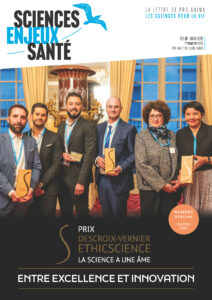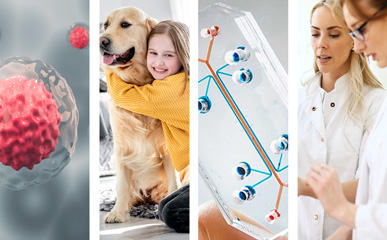
Outdated animal experiments for neurology, Endometriosis Awareness Month, £600k awarded by the NC3Rs for NAMs and more
News on non-animal methods
March 4 - 8, 2024NEWS, REPORTS & POSITION STATEMENTS
1. Moving past animal experiments to understand human neurological disease
The science is now clear : It’s time to challenge the prevailing use of animals for studying the brain and human neurological diseases.
The degree of translation for neurological disorders is so poor — for example, the current failure rate for Alzheimer’s drugs is 99.6% — that the National Academies of Sciences, Engineering, and Medicine concluded that : “Advances in genetics and other new technologies are beginning to bring forth new molecular targets and identify new biomarkers”, and that these are “opportunities to accelerate early stages of drug development for nervous system disorders in the absence of animal models that reflect disease and predict efficacy.”
Richard J. Miller, PhD, Professor Emeritus of Pharmacology at Northwestern University Feinberg School of Medicine, says that the belief monkeys and other animals are essential for performing translationally useful research for human neurological disease is outdated and incompatible with 21st-century science.
2. Validation, Qualification, and Regulatory Acceptance of New Approach Methodologies by ICCVAM*
*Interagency Coordinating Committee on the Validation of Alternative Methods
This document, published in March 2024 and prepared by the ICCVAM Validation Workgroup with input from stakeholders, describes an approach to NAMs validation that reflects modern toxicity testing, placing less emphasis on replacement of in vivo tests with a single alternative method and more emphasis on integrating results from multiple in vitro and in chemico assays and in silico approaches. Guided by the principles articulated in the 2018 ICCVAM Strategic Roadmap, it presents a flexible approach to how confidence is established to help ensure the adoption of new methods by federal agencies and regulated industries once validated for a specific application or context of use.
3. Good practices and resources to improve the utility of research data in regulatory assessments, webinar outcome report by the JRC
The EU Chemicals Strategy for Sustainability stressed the need to improve the regulatory uptake of research data. Since this is a common challenge across countries and policy areas, an expert ground of the OECD Working Party on Hazard Assessment (WPHA) is currently developing a Guidance Document to define and promote good practices to improve regulatory uptake of non-standard scientific data. The guidance targets both the research community and regulatory assessors. The guidance defines good practices and general reliability criteria for regulatory consideration of research data. It will provide an entry point to identify existing resources, standards and tools available for specific data types.
The objectives of this webinar were : to raise awareness of the policy challenge and of the related OECD WPHA initiative, to collect inputs from researchers active in the development of good practice, reporting standards or data management solutions, to engage scientists in supporting the implementation of the guidance.
4. Advancing ethical research practices & opportunities for NAMs under REACH : views by Peptimatrix and Tox Navigation
In recent years, animal-based research has often raised ethical concerns and has come under scrutiny for how biologically relevant it is, and whether it reliably can predict human outcomes. This month, congress at Washington, D.C. introduced the FDA Modernization Act 3.0, a new bill that establishes clear guidelines for development and adoption of new testing methods to reduce or replace the use of animals in non-clinical testing, including cell-based assays and computer modelling. In the article from Peptimatrix, Mikayla Shelton highlights the fact that by supporting these innovative technologies, researchers can better uphold ethical standards, as well as promote the sustainability of their research for future generations. In addition, she argues that by embracing more human-relevant models, researchers can expect their research outcomes to be more applicable to human biology, and therefore accelerate scientific discovery and desired clinical trial outcomes.
In the realm of chemical safety, the Registration, Evaluation, Authorisation, and Restriction of Chemicals (REACH) framework stands as a pivotal system for safeguarding human health and the environment. However, the current approach might be overlooking crucial aspects of chemical exposure. A recent paper caught the attention of Elena Fioravanzo from Tox Navigation, as the study, which analysed the mandated studies required under REACH for different annual tonnage bands, shed light on the information gap for low tonnage chemicals. What the paper and the article emphasize is the idea that NAMs could find their initial application precisely where they are needed most — assessing chemicals in the lower tonnage bands. This presents an opportunity for both registrants and regulators to gain valuable experience in utilizing these innovative methodologies.
Read the article by Peptimatrix
Read the article from Tox Navigation
5. Endometriosis : Animal Research is Holding Back Progress, by Science Advancement and Outreach
March is Endometriosis Awareness Month. Besides the considerable lack of research funding for women’s health issues, it is important to discuss how the use of animal models for endometrial disorders continues to fail patients. For more than 20 years, experimenters have been using mice, rats, rabbits, monkeys and other animals in attempts to study and develop treatments for human endometrial disorders. However, animal-based research methods are not providing translatable data for the clinical community.
Endometrial organoids and assembloids derived from human cells display structural, biological, and pathological features that better mimic the disease’s effects and treatment response in humans. Some models have even been personalized through the use of individual patient samples.
Check out papers on how to improve research for endometrial diseases
6. InterNICHE presents : Surgery and the SynDaver Canine film
Surgery and the SynDaver Canine is a 37-min documentary film that provides a case study of an advanced synthetic model with multiple functionalities for veterinary clinical skills and surgery training.
The film features interviews with university teachers and developers, expert demonstrations of structure and function, and footage of student practical classes for training in abdominal surgery. It is part of the documentary film series DVM : Training the Animal Doctor. The series follows the trajectory of a veterinary degree and explores how humane innovations are replacing animal experiments and enhancing veterinary education across the disciplines — and across the world.
INTERVIEWS, NOMINATIONS, AWARDS
7. £600k awarded by the NC3Rs for proof-of-concept studies to advance the development of NAMs
Six teams have been awarded up to £100k each in CRACK IT Challenge funding to deliver proof-of-concept studies to address two Challenges, SensOoChip and CrossDART, that aim to accelerate the development and use of NAMs.
SensOoChip focuses on liver and heart organs-on-chips (OoCs) as examples to demonstrate that continuous in-line monitoring improves the useability, robustness and understanding of baseline OoC physiology and their responses to drugs.
CrossDART aims at developing and qualify an in vitro approach that can reliably predict early or surrogate indicators of teratogenicity (the ability to cause foetal anomalies or deformities) of pharmaceutical drug candidates.
Among the sponsors of the Challenges : AstraZeneca, Bayer AG, GSK, Merck Healthcare KGaA, Novartis, UCB, and Roche.
TOOLS, PLATFORMS, CALLS
8. Introducing COST Action AtheroNET : a Network for implementing multiomics approaches in atherosclerotic CVDs prevention and research
Despite considerable life-saving progress, cardiovascular diseases (CVDs) remain the leading cause of death globally, claiming an estimated 17.9 million lives each year. Most CVD-related deaths are from heart attacks and strokes, with a significant portion occurring prematurely in people under 70 years of age.
The Network for implementing multiomics approaches in atherosclerotic cardiovascular disease prevention and research (AtheroNET) intends to consolidate and connect experts from different fields into a pan-European and international network that will focus on the use of multi-omics and imagining technologies and data integration through Artificial Intelligence (AI)/Machine Learning (ML) approaches.
AtheroNET is founded by COST (European Cooperation in Science and Technology), a funding agency for research and innovation networks.
9. Award for 3‑D Human Tissue Models or Alveolar Macrophages to Assess Toxicity or Drug Efficacy in Respiratory Tract
PETA Science Consortium International and Epithelix invite reserachers to apply to win three-dimensional reconstructed human respiratory tissues from Epithelix. The human cell – based tissue models by Epithelix mimic various regions of the respiratory tract and can be used for testing cosmetics, pharmaceuticals, medical device extracts, industrial chemicals, pesticides, and household products.
The deadline to apply for this award is 10 May 2024, and the award winner will be announced later that month.
INDUSTRY, BIOTECH & PARTNERSHIPS
10. Unilever, PETA Science Consortium International, and Abcalis Collaborate to Develop Animal-Free Antibodies
Abcalis, a leader in the antibody field, uses phage display technology to produce animal-free antibodies and provides services to help researchers improve the quality, reliability, and continuity of their tests and experiments by using sequence-defined recombinant antibodies. With funding from Unilever and the PETA Science Consortium, Abcalis will develop the antibodies targeting IL‑6 and IL‑8 (inflammation signaling proteins), which will then be used in Unilever and Science Consortium research and made commercially available to the broader scientific community.
11. GRIPonMASH : a new consortium using OoC and new technologies to improve prevention and care of Metabolic dysfunction-Associated Steatohepatitis (MASH)
With the support of the Innovative Health Initiative Joint Undertaking, the GRIPonMASH consortium unites 27 premier European institutions and companies in a collaborative effort to to improve prevention and care of MASH. The €26 million project seeks to create a sustainable diagnostic platform that provides comprehensive services, from screening and diagnosis to the management and long-term follow-up of high-risk patients. It will leverage artificial intelligence-based decision support tools for detecting MASH patients, develop non-invasive diagnostic alternatives, and personalize lifestyle advice to mitigate disease impact effectively.
SCIENTIFIC DISCOVERIES & PROTOCOLS
12. Preparation of a universally usable, animal product free, defined medium for 2D and 3D culturing of normal and cancer cells
Since 1958, cell culture media supplemented with fetal bovine serum is used, despite the well-known concerns about animal welfare, reproducibility, reliability, relevance, and safety. To obliterate these concerns and increase scientific accuracy, Tilo Weber, Jeffrey Bajramovic, Stina Oredsson recently published an open access, publicly available paper on a defined medium composition to make it possible for any lab to prepare this medium.
The medium supports routine culturing and cell banking as well as all important aspects for research and toxicology. The article gives a detailed description of how to mix the defined universal cell culture medium in 14 simple steps to support any entity that wishes to make it.
13. Organoids vascularised in vitro : a remarkable advance by CEA researchers
Organoids have now entered the field of personalised medicine, regenerative medicine and pharmacological research. To this end, the teams from IRIG and CEA-LETI have developed an innovative microfluidic platform to ensure that organoids are properly vascularized, thus promoting their maturation in vitro.
For the first time in the world, by vascularizing organoids in vitro on a microfluidic chip, and maintaining them in culture for 30 days, researchers have observed a significant improvement in their growth, maturation and physiological functions, virtually equivalent to those observed after xenotransplantation in mice. This technology represents a significant advance, and offers an alternative to animal experimentation.
14. Researchers CHOOSE Organoids to Investigate Neurodevelopment
No two brains are the same. This is well known in life and science, but why brains develop divergently in autism spectrum disorder (ASD) is a mystery that persists in neurobiology research. Many genetic studies indicate that ASD likely arises early during fetal stages of development. However, researchers are still trying to connect the genetics to the cellular trajectories that diverge during ASD development. Now, in work published in Nature, a 3D variation of pooled CRISPR screens could connect the dots between autism spectrum disorder genetics and cell fate pathways in the developing brain.
By building cerebral organoids and mapping individual cell fates, Knoblich and his research team, from the Institute of Molecular Biotechnology in Vienna,connected well-established genetics to less comprehensively considered developmental pathways.


